A Deep Dive into the World of Painted Turtles
The painted turtle, a familiar sight across much of North America, embodies resilience and adaptability. With their striking markings and generally placid nature, these reptiles capture the imagination of nature enthusiasts and serve as vital components of their ecosystems. This guide explores the multifaceted life of the painted turtle, from its natural history and behavior to its role in the environment and interactions with humans.
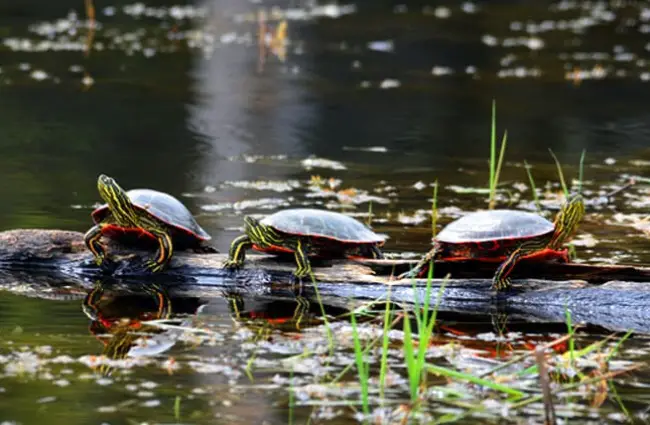
What is a Painted Turtle?
Painted turtles (Chrysemys picta) are freshwater turtles belonging to the family Emydidae. They are named for the vibrant red, orange, and yellow markings on their shells, heads, and legs—though coloration can vary depending on subspecies and age. These medium-sized turtles typically reach lengths of 5 to 10 inches, with females generally being larger than males. Four distinct subspecies are recognized, each with subtle variations in appearance and geographical distribution: the Eastern painted turtle, the Western painted turtle, the Southern painted turtle, and the Plains painted turtle.
Habitat and Distribution
Painted turtles boast an impressive range, stretching from Canada to Mexico and across much of the United States. They inhabit a variety of freshwater environments, including ponds, lakes, marshes, slow-moving rivers, and streams. A key requirement is the presence of basking sites, such as logs, rocks, or vegetation, where turtles can absorb warmth from the sun. They also need muddy or sandy bottoms for foraging and constructing nests. The Western painted turtle is especially adapted to the drier conditions of the western plains.
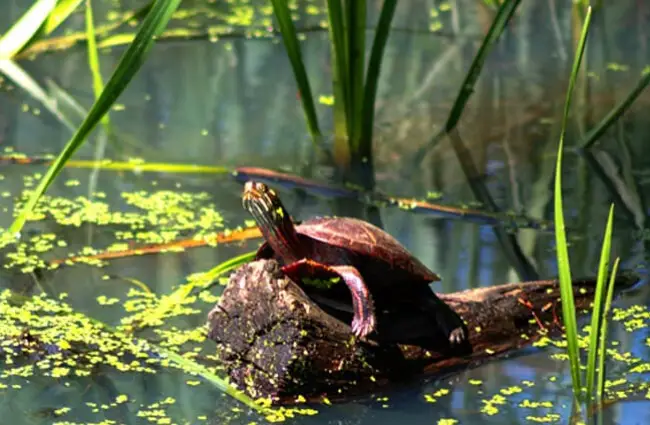
Diet and Foraging Behavior
Painted turtles are omnivorous, meaning their diet consists of both plants and animals. Young turtles tend to be more carnivorous, feeding on insects, crustaceans, tadpoles, and small fish. As they mature, their diet shifts to include more aquatic vegetation, algae, fruits, and occasionally carrion. They are opportunistic feeders, consuming whatever is readily available. Painted turtles typically forage in shallow water, using their keen eyesight to locate food. They can also ambush prey or scavenge on the bottom.
Life Cycle and Reproduction
Painted turtles have a relatively long lifespan, often exceeding 50 years in the wild. They reach sexual maturity between 4 and 7 years of age. Mating typically occurs in the spring, often in shallow water. Males court females through a series of movements and displays. After mating, the female searches for a suitable nesting site—usually a sunny, sandy or loamy bank. She digs a nest cavity, lays a clutch of 4 to 24 eggs, and then covers the nest with soil and vegetation.
Incubation lasts between 60 and 90 days, depending on temperature. Warmer temperatures produce more females, while cooler temperatures produce more males. Hatchlings emerge from the nest in late summer or early fall. They are vulnerable to predators, so they often remain hidden in vegetation for several weeks. The sex of the turtle is determined by temperature during incubation, a phenomenon known as temperature-dependent sex determination.

Ecological Role and Interactions
Painted turtles play a vital role in their ecosystems. As omnivores, they help to control populations of insects, crustaceans, and aquatic plants. They also serve as a food source for predators such as raccoons, foxes, herons, and snapping turtles. Their basking behavior can also benefit other species. Algae often grow on their shells, providing a food source for small invertebrates. Their nests can create microhabitats for plants and animals. They compete with other turtles for food and basking sites. Understanding these interactions is key to conserving painted turtle populations.
Painted Turtles and Humans
Historically, painted turtles were harvested for food and used in traditional medicine. Today, they are generally protected by law, although some harvesting still occurs in certain areas. Habitat loss and fragmentation pose the greatest threats to painted turtle populations. Road mortality is also a significant concern, as turtles often cross roads to reach nesting sites. Conservation efforts include protecting and restoring wetland habitats, creating wildlife corridors, and reducing road mortality.
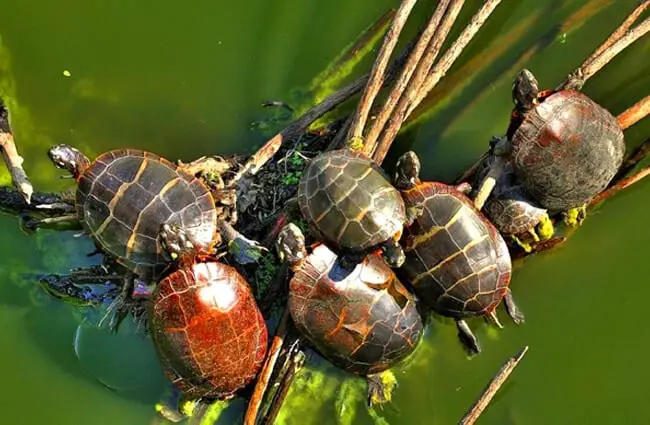
Identifying Painted Turtle Subspecies
Differentiating between the four subspecies can be challenging, but there are key characteristics to look for. The Eastern painted turtle (Chrysemys picta picta) features a broad red plastron (the underside of the shell) and often has red markings on the margins of the shell. The Western painted turtle (Chrysemys picta bellii) typically has a yellow plastron and a more extensive network of orange and red markings on the periphery of the shell. The Southern painted turtle (Chrysemys picta dorsalis) often exhibits a more muted coloration, with less vibrant markings. The Plains painted turtle (Chrysemys picta emoryi) is characterized by its narrow red markings and often has a dark carapace (the upper shell).
Painted Turtles in Captivity
While not typically recommended due to the complexity of their care, painted turtles are sometimes kept in captivity. A large outdoor pond or spacious indoor aquarium with appropriate UVB and heat lamps is essential. A varied diet consisting of aquatic plants, insects, and commercial turtle food is necessary. Regular water changes and a clean basking area are crucial for maintaining their health. It is important to remember that painted turtles can live for many decades, so owning one is a long-term commitment. Providing a naturalistic habitat and enrichment opportunities is essential for their well-being.
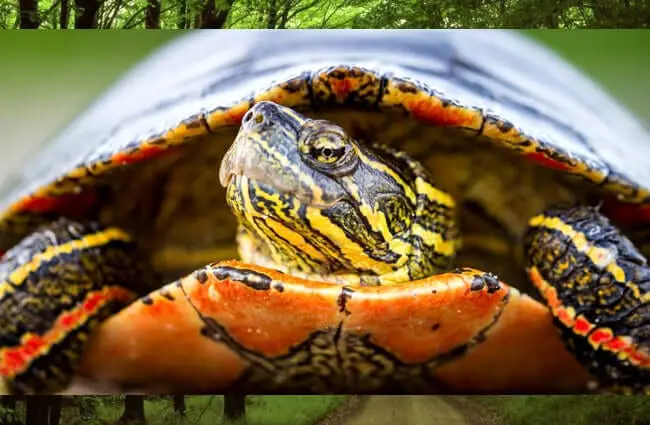
Fun Facts About Painted Turtles
- Painted turtles can brumate (a reptile equivalent of hibernation) during the winter months, becoming less active and seeking refuge in mud or under vegetation.
- They can hold their breath for extended periods, allowing them to remain submerged for up to an hour.
- Hatchling painted turtles are very small, typically measuring only 1 to 2 inches in length.
- They are among the most widely distributed turtles in North America.
- The vibrant colors on their shells and bodies can fade with age.
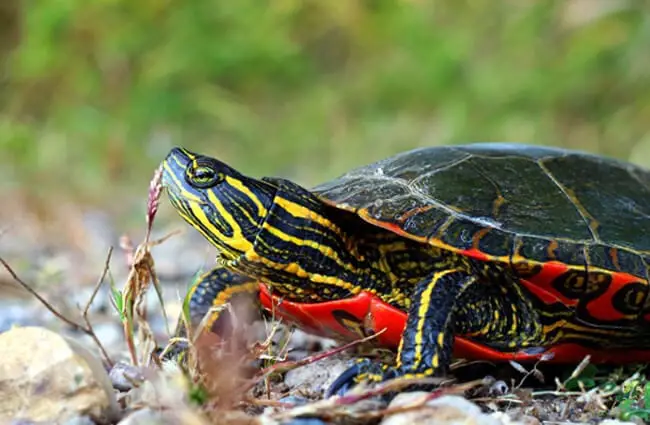
The painted turtle, a resilient and captivating reptile, continues to thrive across North America. By understanding its biology, ecology, and interactions with humans, we can better appreciate and protect this remarkable species for generations to come. Their adaptability and widespread distribution make them a true symbol of North American wilderness.

![Red Angus Closeup of a beautiful Red Angus cowPhoto by: U.S. Department of Agriculture [pubic domain]https://creativecommons.org/licenses/by/2.0/](https://animals.net/wp-content/uploads/2020/03/Red-Angus-4-238x178.jpg)




![Red Angus Closeup of a beautiful Red Angus cowPhoto by: U.S. Department of Agriculture [pubic domain]https://creativecommons.org/licenses/by/2.0/](https://animals.net/wp-content/uploads/2020/03/Red-Angus-4-100x75.jpg)

